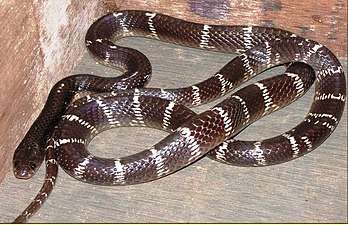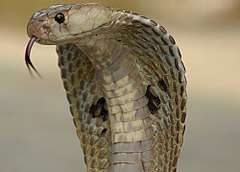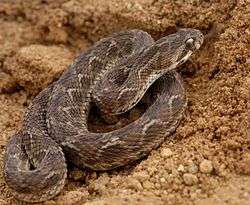Venomous snake
Venomous snakes are species of the suborder Serpentes that are capable of producing venom, which is used primarily for immobilizing prey and defense mostly via mechanical injection by fangs. Common venomous snakes include the families Elapidae, Viperidae, Atractaspididae, and some of the Colubridae. The toxicity of them is mainly indicated by murine LD50, while multiple factors are considered to judge their potential danger to humans.
Evolution
The evolutionary history of venomous snakes can be traced back to as far as 25 million years ago.[1] Snake venom is actually modified saliva used for prey immobilization and self-defense and is usually delivered through highly specialized teeth, hollow fangs, directly into the bloodstream or tissue of the target. Evidence has recently been presented for the Toxicofera hypothesis, but venom was present (in small amounts) in the ancestors of all snakes (as well as several lizard families) as "toxic saliva" and evolved to extremes in those snake families normally classified as venomous by parallel evolution. The Toxicofera hypothesis further implies that "nonvenomous" snake lineages have either lost the ability to produce venom (but may still have lingering venom pseudogenes), or actually do produce venom in small quantities, likely sufficient to help capture small prey but causing no harm to humans when bitten.
Taxonomy
There is not a single or special taxonomic group for venomous snakes that comprise species from different families. This has been interpreted to mean venom in snakes originated more than once as the result of convergent evolution. Around a quarter of all snake species are identified as being venomous.
| Family | Description |
|---|---|
| Atractaspididae (atractaspidids) | Burrowing asps, mole vipers, stiletto snakes |
| Colubridae (colubrids) | Most are harmless, but others have potent venom and at least five species, including the boomslang (Dispholidus typus), have caused human fatalities. |
| Elapidae (elapids) | Sea snakes, taipans, brown snakes, coral snakes, kraits, death adders, tiger snakes, mambas, king cobra and cobras |
| Viperidae (viperids) | True vipers, including the Russell's viper, saw-scaled vipers, puff adders and pit vipers, including rattlesnakes, lanceheads and copperheads and cottonmouths. |
Terminology
Venomous snakes are often said to be poisonous, but poison and venom are not the same thing. Poisons must be ingested, inhaled or absorbed, while venom must be injected into the body by mechanical means. While unusual, there are a few species of snake which are actually poisonous. Rhabdophis keelback snakes are both venomous and poisonous - their poisons are stored in nuchal glands and are acquired by sequestering toxins from poisonous toads the snakes eat.[2] Similarly, certain garter snakes from Oregon can retain toxins in their livers from ingesting rough-skinned newts.[3]
Danger

Toxicity issues
LD50, mostly on rodents, is a common indicator of snakes' toxicity with a smaller resultant value indicating a higher level of toxicity. There have been numerous studies on snake venom with a variability of potency estimates.[4] There are four methods in which the LD50 test is conducted, which are injections to subcutis (SC), vein (IV), muscle (IM or IC), and peritoneum (IP). The former (SC) is most applicable to actual bites as only vipers with large fangs, such as large Bitis, Bothrops, Crotalus, or Daboia specimens, would be able to deliver a bite that is truly intramuscular, and snakebites rarely cause IV envenomation. Testing using dry venom mixed with 0.1% bovine serum albumin in saline, gives more consistent results than just saline alone.
Belcher's sea snake (Hydrophis belcheri ), which many times is mistakenly called the hook-nosed sea snake (Enhydrina schistosa), has been erroneously popularized as the most venomous snake in the world, due to the first edition of Ernst and Zug's book, Snakes in Question: The Smithsonian Answer Book, published in 1996. Prominent venom expert Associate Professor Bryan Grieg Fry has clarified the error: "The hook nosed myth was due to a fundamental error in a book called Snakes in Question. In there, all the toxicity testing results were lumped in together, regardless of the mode of testing (e.g., subcutaneous vs. intramuscular vs. intravenous vs. intraperitoneal). As the mode can influence the relative number, venoms can only be compared within a mode. Otherwise, it's apples and rocks."[5] Belcher's sea snake's actual LD50 (recorded only intramuscularly) is 0.24 mg/kg[6] and 0.155 mg/kg,.[7] Studies on mice[8][9][10] and human cardiac cell culture[5][11][12] show that venom of the inland taipan, drop by drop, is the most toxic among all snakes.
| Snake | Region | subcutaneous injection LD50 0.1% bovine serum albumin in Saline | subcutaneous injection LD50 Saline | intravenous injection LD50 |
| Inland taipan | Australia | 0.01 mg/kg | 0.025 mg/kg | N/A |
| Dubois' sea snake | Coral Sea, Arafura Sea, Timor Sea, Tar River, and Indian Ocean | N/A | 0.044 mg/kg | N/A |
| Eastern brown snake | Australia, Papua New Guinea, Indonesia | 0.041 mg/kg | 0.053 mg/kg | 0.01 mg/kg |
| Yellow bellied sea snake | Tropical oceanic waters | N/A | 0.067 mg/kg | N/A |
| Peron's sea snake | Gulf of Siam, Strait of Taiwan, Coral sea islands, and other places | N/A | 0.079 mg/kg | N/A |
| Coastal taipan | Australia | 0.064 mg/kg | 0.105 mg/kg | 0.013 mg/kg |
| Many-banded krait | Mainland China, Taiwan, Vietnam, Laos, Burma | N/A | 0.108 mg/kg | 0.061 mg/kg |
| Black-banded sea krait | eastern coast of the Malay Peninsula and Brunei, and in Halmahera, Indonesia.. | N/A | 0.111 mg/kg | N/A |
| Black Tiger snake | Australia | 0.099 mg/kg | 0.131 mg/kg | N/A |
| Mainland Tiger snake | Australia | 0.118 mg/kg | 0.118 mg/kg | 0.014 mg/kg |
| Western Australian Tiger snake | Australia | 0.124 mg/kg | 0.194 mg/kg | N/A |
| Beaked sea snake | Tropical Indo-Pacific | 0.164 mg/kg | 0.1125 mg/kg | N/A |
Other factors
Toxicity of snake venom (based on laboratory tests conducted on mice) is sometimes used to gauge the extent of their danger to humans, but this is not enough. Many venomous snakes are specialized predators whose venom may be adapted specifically to incapacitate their preferred prey.[15] A number of other factors are also critical in determining the potential hazard of any given venomous snake to humans, including their distribution and behavior.[16][17] For example, while the inland taipan is regarded as the world's most venomous snake based on LD50 tests on mice, it is a shy species and rarely strikes, and has not caused any known human fatalities. On the other hand, India's Big Four (Indian cobra, common krait, Russell's viper, and saw-scaled viper), while less venomous than the inland taipan, are found in closer proximity to human settlements and are more confrontational, thus leading to more deaths from snakebite. In addition, some species, such as the black mamba and coastal taipan, occasionally show some aggression, generally when alarmed or in self-defence, and then may deliver fatal doses of venom, resulting in high human mortality rates.[18][19]
See also
References
- ↑ McCartney, JA; Stevens, NJ; O'Connor, PM (March 20, 2014), "Oldest fossil evidence of modern African venomous snakes found in Tanzania", PLoS ONE, Ohio University, 9: e90415, doi:10.1371/journal.pone.0090415, PMC 3960104, PMID 24646522
- ↑ Klauber LM. (1997). Rattlesnakes: Their Habitats, Life Histories, and Influence on Mankind (2 ed.). Berkeley: University of California Press, Berkeley, 1956, 1972. ISBN 0-520-21056-5.
- ↑ Williams, Becky L.; Brodie Jr., Edmund D.; Brodie III, Edmund D. (2004). "A resistant predator and its toxic prey: persistence of newt toxin leads to poisonous (not venomous) snakes". Journal of Chemical Ecology. 30 (10): 1901–1919. doi:10.1023/B:JOEC.0000045585.77875.09.
- ↑ Mackessy, Stephen P. (June 2002). "Biochemistry and pharmacology of colubrid snake venoms" (PDF). Journal of Toxicology: Toxin Reviews. 21 (1–2): 43–83. doi:10.1081/TXR-120004741. Archived from the original (PDF) on 2010-06-02. Retrieved 2009-09-26.
- 1 2 Fry, Bryan Archived 2014-04-19 at the Wayback Machine. (February 08, 2005) Most Venomous Archived 2014-10-17 at the Wayback Machine.,"Q;I was wondering what snakes venom is the most potent to humans A:Drop for drop it is the inland taipan (Oxyuranus microlepidotus), which has a venom more toxic than any other land snake or even the sea snakes." venomdoc.com Forums, Retrieved April 17, 2014
- ↑ Tamiya, N; Puffer, H (1974). "Lethality of sea snake venoms". Toxicon. 12 (1): 85–7. doi:10.1016/0041-0101(74)90104-4. PMID 4818649.
- 1 2 Fry, B. Associate professor, School of Biological Sciences, University of Queensland (February 24, 2012). "Snakes Venom LD50 – list of the available data and sorted by route of injection ". venomdoc.com. (archived) Retrieved October 14, 2013.
- ↑
- The Australian venom research unit (August 25, 2007). "Which snakes are the most venomous?". University of Melbourne. Retrieved October 14, 2013.
- Venom Immunochemistry, Pharmacology and Emergency Response (VIPER) Institute. Frequently Asked Questions -What is the most venomous snake?. "Many experts answer that it is the Inland Taipan of Australia, because its drop-by-drop concentration of venom has great potency when measured by its ability to kill rodents" . University of Arizona. Retrieved October 14, 2013.
- Department of Wildlife Ecology and Conservation. Frequently Asked Questions About Venomous Snakes. "A comparative study found that the snake venom that is most toxic to mice (of the species tested) is that of the Inland Taipan (Oxyuranus microlepidotus), found in Australia". University of Florida. Retrieved November 5, 2013.
- Hodgson WC, Dal Belo CA, Rowan EG (2007). "The neuromuscular activity of paradoxin: a presynaptic neurotoxin from the venom of the inland taipan (Oxyuranus microlepidotus)". Neuropharmacology. 52 (5): 1229–36. doi:10.1016/j.neuropharm.2007.01.002. PMID 17313963.
The inland taipan is the world's most venomous snake
- Bell, Karen L; Sutherland, Struan K; Hodgson, Wayne C (1998). "Some pharmacological studies of venom from the inland taipan (Oxyuranus microlepidotus)". Toxicon. 36 (1): 63–74. doi:10.1016/S0041-0101(97)00060-3. PMID 9604283.
The Inland Taipan is believed to have the most toxic venom in the world (Sutherland, 1994)
- Journal of Herpetology Vol.17 no.1 (1983) Ecology of Highly Venoumous Snakes: the Australian Genus Oxyuranus. "..the number of mouse LD50 doses per bite is much higher for Oxyuranus microlepidotus (218,000 mice)...than for any other snakes, including sea snakes, investigated to date (Broad, Sutherland and Coulter, 1979)." (page 1) University of Sydney. Retrieved November 8, 2013.
- ↑
- LISTS . Nine of the World's Deadliest Snakes. "#1: The snake with the world's deadliest venom - Oxyuranus microlepidotus" . Encyclopædia Britannica. Retrieved November 5, 2013.
- BBC Nature Wildlife. Inland Taipan page. "Australia's inland taipan is considered to be the most venomous snake in the world". BBC. Retrieved October 15, 2013.
- Cecilie Beatson (November 29, 2011). ANIMAL SPECIES:Inland Taipan "The venom of the Inland Taipan is extremely potent and is rated as the most toxic of all snake venoms in LD50 tests on mice". Australian Museum. Retrieved October 14, 2013.
- Steve Irwin presentation .Australia Zoo Tour with Steve Irwin (1m54s) "..the number 1 most venomous snake in the entire world, the fierce snake". Australia Zoo (official Youtube Channel). Retrieved October 14, 2013.
- ↑ Inland Taipan Venom vs. Sea Snakes Venom (most notable Belcher's sea snake)
- Oakley, Cecily (2011). Interview with Associate Professor Bryan Fry Biochemist and molecular biologist Archived 2013-10-22 at the Wayback Machine.. "...For my PhD, I worked on the inland taipan, which is the world’s most venomous snake..." . Australian Academy of Science. Retrieved October 14, 2013.
- kingsnake.com September Guest Chatter (September 16, 2006).Q&A with Dr. Bryan Grieg Fry, Deputy Director, Australian Venom Research Unit, University of Melbourne Archived 2012-10-15 at the Wayback Machine.. "Q: In retrospect to the LD50 charts, what do you personally feel is the hottest snake, in regards to potency, defensiveness, means of injection, etc.? A: It is the inland taipan (Oxyuranus microlepidotus). Not, as is popularised, any of the sea snakes." connectedbypets.com. Retrieved October 14, 2013.
- Garden of Eden Exotics (May 2, 2012) Dr. Bryan Grieg Fry – Interview "...The inland taipan (Oxyuranus microlepidotus') is far and away the most toxic, much more so than even sea snakes." nyexotics.blogspot.com Retrieved October 14, 2013
- ↑ Seymour, Jamie, World's Worst Venom, (Min 44.33) "Among the reptiles tested, the most toxic venom belongs to inland taipan, killing over 60% of heart cells in the first 10 minutes" National Geographic Channel Retrieved April 17, 2014
- ↑ Seymour, Jamie Venom deathmatch "They have the most toxic venom towards humans then any other snake in the world" (min 1:49) National Geographic Channel, Retrieved April 17, 2014
- ↑ Broad and Sutherland, 1979. The lethality in mice of dangerous australian and other snake venom Toxicon vol. 17 Retrieved April 8, 2014
- ↑ The Australian venom research unit (January 11, 2014). Facts and Figures: World's Most Venomous Snakes. University of Melbourne. Retrieved July 14, 2014.
- ↑ "What is an LD50 and LC50".
- ↑ "Most venomous snakes". Reptile Gardens. Retrieved October 13, 2014.
- ↑ Walls, Jerry G. "Deadly Snakes: What are the world's most deadly venomous snakes?". Reptiles. Retrieved November 5, 2013.
- ↑ Davidson, Terence. "IMMEDIATE FIRST AID - Black Mamba". University of California, San Diego. Retrieved 2010-05-12.
- ↑ "IMMEDIATE FIRST AID for bites by Australian taipan or common taipan".
External links
| Wikivoyage has a travel guide for Venomous snakes. |
- Venomous snakes and outdoor workers Bite-prevention and treatment information for outdoor workers.



